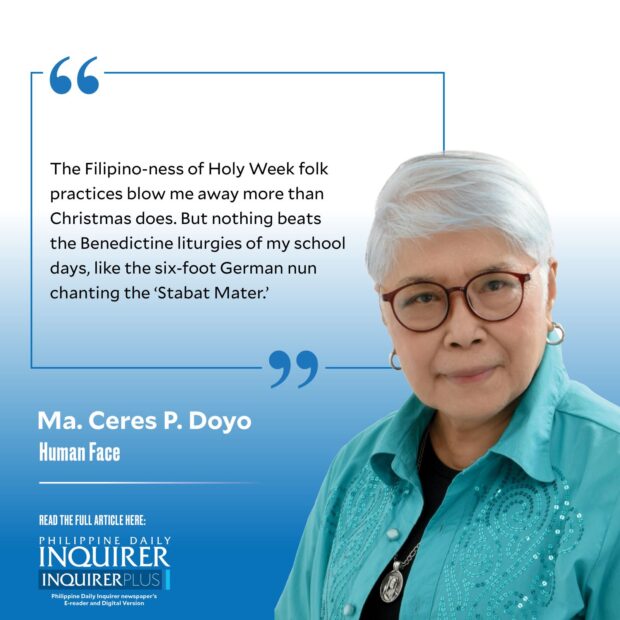Holy Week ‘promdi’ notes

FYI, “promdi” is short for “from the province.” Sounds deprecatory but I am proudly promdi.
And so the yearly hometown rites of Holy Week are upon us. In front of our house in Iloilo is the second station of the Cross, one of 16 (up from the original 14) dotting the sidewalks of the first-class Dumangas poblacion. The Filipinos’ via crucis (way of the cross) sure has become longer, di bala?
Our family’s carro with the statue of St. Joseph of Arimathea (the wealthy man in the Bible who provided the tomb for Jesus) is being readied for the long procession of characters in Jesus’ passion and death drama that Christians, Catholics mostly, commemorate during Lent. The townsfolk will be there in procession, braving the burning heat followed, as I remember, by a brass band (perhaps playing Frédéric Chopin’s “Marche Funèbre”).
Article continues after this advertisementBehold the carro with St. Joseph, decked with nonwilting flowers, waiting in front of the house where I grew up. Our house, with the caduceus symbol prominently embossed on its façade, is now on the town’s heritage list, whatever that means.
A five-minute walk away is the parish church of St. Augustine (founded in 1575 and rebuilt circa the 1800s) where I was baptized. Like many churches in the Philippines, it faces the town plaza. (Across it is the Philippine Independent Church.) Built with bricks (and egg whites?) by the Spanish Augustinians, it has been declared a historical site by the National Historical Commission of the Philippines.
On my Bicol (Albay) maternal side, my grandma had her version of the sorrowful mother, the Nuestra Señora de Angustias which she adorned herself. It has been donated to the parish and is part of the Holy Week procession. (Its photo landed in the Inquirer during the pandemic.)
Article continues after this advertisementTo backtrack, it is Palm Sunday that begins the Holy Week drama when, the Bible says, Jesus entered Jerusalem astride the beast of burden that is the donkey, the humble ass whose name is used in vituperative utterances. Hereabouts, intricately woven coconut fronds will have their time of day, their artistic creators and hawkers making brisk sales. I put my blessed palm in a tall vase with water for it to last the whole Holy Week.
Jesus’ lamentation “Jerusalem, Jerusalem, … how often have I longed to gather your children, as a hen gathers her chicks under her wings, but you wouldn’t let me,” is a favorite of mine, an example of how the sound of words and cadence can enhance meaning and make it stick. And there is “If I forget you, O Jerusalem” from the Psalms, the Jerusalem that is now at the heart of bloody conflicts between people who call God by different names. But I digress.
As a kid, I had my part singing “Hosanna” and, from a raised platform, throwing flowers on the passing Jesus. I remember myself in a frilly yellow dress and carrying a basket of flowers like so many girls my age, most of them my playmates, who are now scattered all over the world.
But on early Easter morning, I was just one of many spectators of the meeting of the resurrected Jesus and his mother Mary (an apocryphal Filipino version of an Easter scene), in Tagalog, the salubong. A lightweight girl would be raised and placed inside a star hanging in midair. Not for the acrophobic. When the statue of the grieving Mary was about to pass by, the star would be lowered and the girl let out to lift Mary’s veil of sorrow. I was never considered for the role for obvious reasons. I was too healthy, bug-at. I am no kill-joy but I now wonder if that particular Easter palabas could be considered endangerment of minors.
What are your Holy Week recollections that are like no other? I do not remember flagellants in Iloilo who whipped themselves on the back with instruments that had sharp nails attached to them. I remember being in Pampanga one Good Friday and seeing bare-breasted male penitents flogging themselves. Blood spurts flew, some landing on my parked car. Discouraged by the church hierarchy, real-life crucifixions in Pampanga continue to be practiced and attract tourists.
The chanting of the “Pasión” was not part of the Holy Week rituals in our town in Iloilo. Might this be a tradition in Tagalog-speaking regions only? But pilgrims trekked to Balaan Bukid (holy mountain) on Guimaras Island.
There is a book series on hometowns, among them, “The Bohol We Love,” “The Dumaguete We Know,” etc. What about a mixed bag by writers from different provinces: “Promdi Past: Hometown Memories from the 20th Century.” We are in the 21st century when malls are taking over hometown memories.
The Filipino-ness of Holy Week folk practices blow me away more than Christmas does. But nothing beats the Benedictine liturgies of my school days, like the six-foot German nun chanting the “Stabat Mater.” May the memories stoke the embers of your faith as they do mine.
—————-
Send feedback to cerespd@gmail.com
















